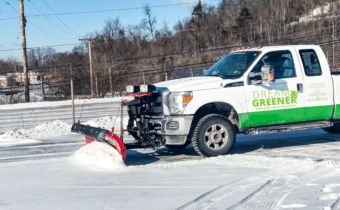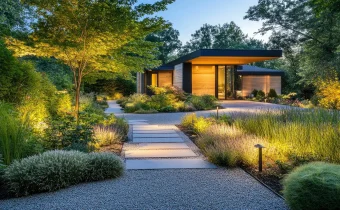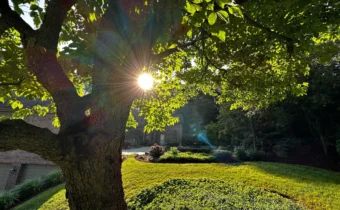As we move through August in Pittsburgh, many lawns are showing signs of stress—from extended rains in spring to summer heat and humidity. That means now is the time to act to keep your turf looking its best, whether you’re one of our Dream Greener lawn care or lawn mowing clients or tackling lawn care yourself.
Pittsburgh’s Volatile Spring & Summer Weather
Pittsburgh’s spring and early summer haven’t been dramatically wetter than normal, but recent months have shown modest increases—enough to influence lawn health:
- Year-to-date precipitation (Jan–July): Pittsburgh recorded 23.86 inches, in line with typical seasonal totals according to the National Weather Service.
- Climate trend: A joint report from Axios and Climate Central noted that storm intensity in Pittsburgh has increased nearly 28% since 1970, with more frequent and heavier downpours.
So, while the spring and early summer haven’t been extremely wet, the marginal increase in rain coupled with heavier storms has created conditions that encourage lawn stress and disease—especially when combined with summer heat.
Understanding the Causes of Late-Summer Lawn Stress
Here’s why your lawn may be struggling right now:
A. Excess Moisture + Heat = Disease
Wet spring and early-summer soils keep grass blades wet—creating perfect fungal breeding conditions. Combine that with July and August’s warmer temperatures, and it’s a recipe for turf diseases like dollar spot and summer patch. According to Penn State Extension, both pathogens thrive in warm, wet environments and can quickly damage cool-season grasses common in Western Pennsylvania lawns.
B. Mower Stress & Scalping
Inconsistent mowing or scalping, especially when the grass is already stressed from weather, can weaken turf—even heat-tolerant varieties. Keeping your blades sharp and your mowing height consistent plays a big role in preventing this kind of stress.
If you mow your own lawn, be sure to check out our guide on best lawn mowing practices in Pittsburgh, including height recommendations and seasonal mowing tips. If you’re already a Dream Greener lawn mowing client, you’re in good hands. Our team follows seasonal best practices tailored to your turf, and we monitor conditions carefully throughout the year.
C. Soil Compaction & Thatch Buildup
Heavy spring rain and foot traffic compress the soil, limiting root growth and making grasses more vulnerable—especially under heat and moisture stress.
D. Nutrient Drain from Heavy Rain
Frequent showers can leach nitrogen and other nutrients from the soil, weakening turf going into autumn. This leaching is especially common in Pittsburgh’s clay-rich soils, which already struggle with drainage.
Signs Your Lawn Is Suffering
Is your yard struggling? Here are 5 telltale signs to look out for:
- Light‑tan to bleached patches (1–3″): Likely dollar spot.
- Ring‑shaped, darker brown areas (6–12″): Could be summer patch, which magnifies in compacted soil conditions—again, something Penn State Extension highlights as a widespread issue in our region.
- Spindly or threads of grass between clumps: Indicates thatch and weak turf.
- Thin, sparse areas with poor recovery: Sign of compaction, stress, or nutrient loss.
- Visible soil, wilted blades: Turf nearing dormancy or under duress.
Before assuming it’s just “heat stress,” take time to evaluate. Tug on a few blades. Look for puckered or overly soft soil. Inspect roots and check for signs of fungus. Or give Dream Greener a call to do a lawn analysis!
While late summer stress is often weather-driven, underground pests can also be to blame. If you suspect grub activity, check out our guide to grub control in Pittsburgh lawns, including what to look for and how to respond before fall.
How to Combat Late-Summer Stress
Here are trusted, practical ways to nurse your lawn back to health:
A. Monitor and Treat Lawn Diseases
- Dollar spot: Apply targeted fungicide during active infection; improve airflow and reduce thatch.
- Summer patch: Aerate and improve drainage; use slow-release nitrogen; maintain mowing height of 3″.
According to Cornell University, timely aeration and balanced fertility are essential for managing root-borne fungal infections—especially in turf types like Kentucky bluegrass and fine fescues.
For a deeper dive into disease prevention and treatment, explore our post on how to identify and treat common lawn fungi in Pittsburgh.
Dream Greener’s team can help correctly identify what you’re dealing with and apply professional-grade solutions at the right time.
B. Smart Watering Habits
- Water early in the morning to let grass blades dry before nightfall.
- Deep watering (~1–1.5″ per week) encourages strong roots.
- Avoid watering if rain is forecasted—excessive moisture fuels disease.
C. Adjust Mowing Practices
- Raise mower height to 3″ to promote shading and rooting.
- Never cut more than 1/3 of the grass blade at once.
- Sharpen mower blades to avoid tearing.
D. Dethatch & Aerate the Lawn
- If your thatch layer is more than ½ inch thick, it’s time to dethatch and aerate.
- Late summer is ideal for this work—roots have time to rebuild before cooler weather.
- Aeration improves oxygen, water infiltration, and reduces disease risk, according to Rutgers Cooperative Extension.
E. Fertilize Thoughtfully
- Avoid feeding with quick-release nitrogen during peak summer heat—it may burn turf or promote fungal growth.
- Instead, plan for a slow-release nitrogen fertilizer in early September to support root recovery and carbohydrate storage heading into winter.
F. Prepare for Fall Overseeding
- Late summer (mid-August through early fall) is optimal for seeding—soil is still warm, and weeds are slowing down.
- Overseed thinning lawns after aeration for better seed-to-soil contact.
- Choose turfgrass blends with high disease resistance and regional adaptation. Dream Greener uses seed mixes tested for success in Pennsylvania’s varied growing conditions.
Why This Matters Before Fall
Next month’s blog will focus more on fall lawn prep, but now is the time to get ahead of the curve. Addressing stress now will:
- Reduce disease pressure heading into cooler, wetter months
- Maintain turf color and density
- Improve the success rate of fall aeration and overseeding
- Lay a stronger foundation for spring green-up
Time for a Dream Greener Lawn Evaluation
If you’re seeing strange brown spots, thinning patches, or signs of disease, now is the time for a professional lawn evaluation. Dream Greener can:
- Identify disease types and stress causes
- Tailor a plan to restore your lawn’s health
- Schedule aeration and treatment services before fall arrives
Want to learn more about how we care for Pittsburgh lawns? Explore our full lawn care program or check out our Pittsburgh Lawn & Landscape Maintenance Calendar to understand what we do on a monthly basis.
Don’t Let Summer Win — Reclaim Your Lawn Before Fall
This summer has challenged even the healthiest lawns in Pittsburgh. But you still have time to recover, prepare for fall, and keep your yard looking great into next season.
Whether you need help spotting signs of stress or want professional care from the start, Dream Greener is here to guide the way. Request your lawn evaluation here!



